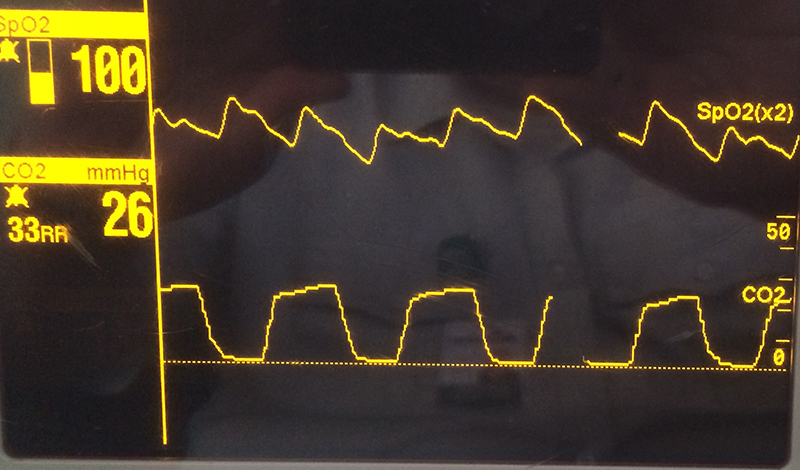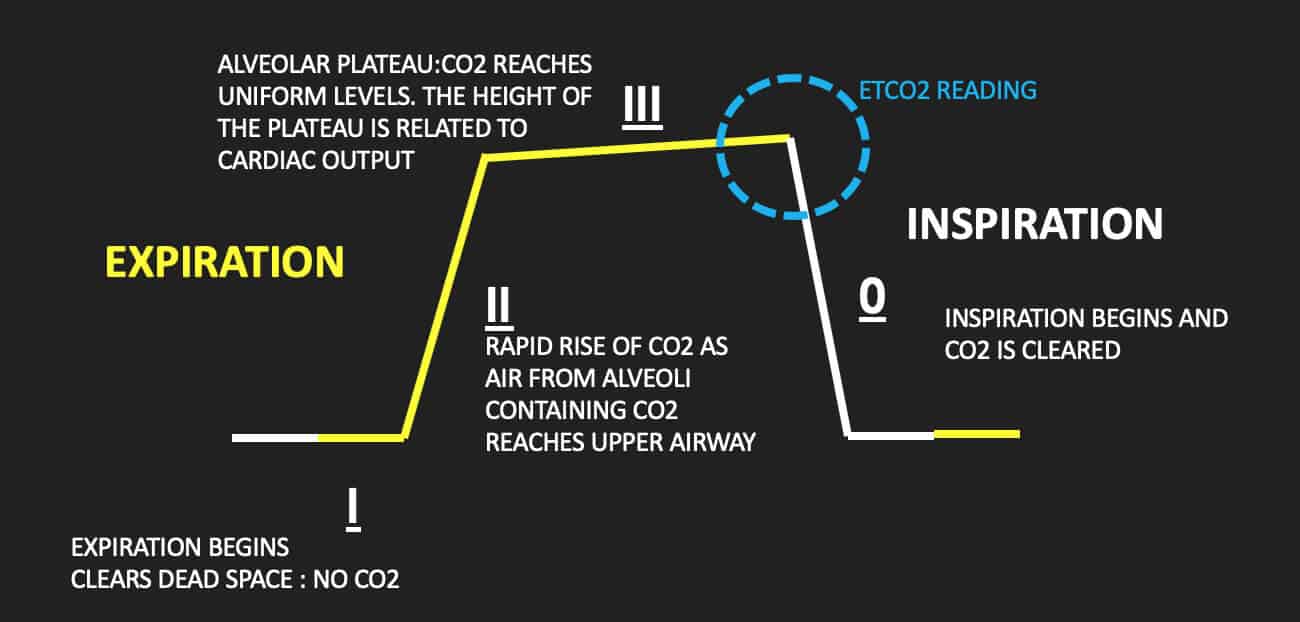end tidal co2 range low
Measurement of a low ETCO 2 value 10 mmHg during CPR in an intubated patient suggests that the quality of chest compressions needs improvement. Subsequently one may also ask what does it mean.

Capnography In The Pediatric Emergency Department Clinical Applications
Once that has been done you can use an end tidal Co2 monitor as opposed to drawing multiple ABGs.

. ETCO2 levels are typically between 4 and 5. End-tidal CO2 EtCO2 monitoring is a noninvasive technique which measures the partial pressure or maximal concentration of carbon dioxide CO2 at the end of an exhaled breath which is expressed as a percentage of CO2 or mmHg. End-tidal carbon dioxide ETCO2 is the level of carbon dioxide that is released at the end of an exhaled breath.
In this study the aim was to review the applications of end-tidal carbon dioxide ETCO2 monitoring in emergency department multiple databases were comprehensively searched with combination of following keywords. End tidal normally 2-5 mmHg lower than arterial Comparing Arterial and End-tidal CO2 Review of Airway Confirmation Visualization Auscultation. ETCO2 emergency department monitoring and critical.
Savastano S et al. The amount of CO2 at the end of exhalation or end-tidal CO2 ETCO2 is normally 35-45 mm HG. This is a major respiratory symptom.
When CO2 diffuses out of the lungs into the exhaled air a device called a capnometer. It is best to get an ABG along side the end tidal to calculate the patients shunt. End-tidal carbon dioxide and defibrillation success in out-of-hospital cardiac arrest.
The minimum ETco2 value was significantly lower in the anaphylaxis group median interquartile range. What Is Normal End Tidal Co2 In Kpa. Continuous Waveform Capnograpy is written as PETCO2 which stands for patient end-tidal carbon dioxide.
Negative Epigastric sounds Equal lung sounds Esophageal detector End tidal CO2 detector Secondary signs. As stated before end tidal is slightly different. ETCO2 levels reflect the adequacy with which carbon dioxide CO2 is carried in the blood back to the lungs and exhaled.
The normal values are 5-6 CO2 which is equivalent to 35-45 mmHg. So the short answer is you are right about the ranges 35-45 but that is for actual PaCo2 drawn from an ABG. Ensure proper rate approximately 100min Ensure proper depth with adequate releaserecoil of thorax 12 thorax or minimum 25 inches Persistently low EtCO.
Capnograph is an indispensable tool for monitoring metabolic and respiratory function. Also called capnometry or capnography this noninvasive technique provides a breath-by-breath analysis and a continuous recording of ventilatory status. A number of studies have shown that expired CO2 concentration is closely related to cardiac output but that cardiac output was not controlled as an independent variable.
Hypercapnia is the leading cause of increased ETCO2 followed by anesthetic-induced hypoventilation. The temperature range is between 6 and 6 kPa 35-45 mmHg. Monitoring of end-tidal carbon dioxide EtCO2 is a noninvasive method that measures the partial pressure or maximal concentration of carbon dioxide CO2 at the end of exhaled breath which is expressed as a percentage of CO2.
Can the value of end tidal CO2 prognosticate ROSC in patients coding into emergency department with an out-of-hospital cardiac arrest. In addition the partial pressure of end-tidal CO2 PETCO2 during extremely low cardiac output has not been reported. End-tidal capnography or end-tidal CO2 EtCO2 monitoring is a non-invasive technique that measures the partial pressure or maximal concentration of carbon dioxide CO2 at the end of an exhaled breath.
The objective of the present study was to measure PETCO2 during well. The number is called capnometry which is the partial pressure of CO 2 detected at the end of exhalation ranging between 35 - 45 mm Hg or 40 57 kPa. The levels of carbon dioxide in normal healthy animals can rise up to seven times.
Since reduced breathing in the sick those with less than 20 s for the body oxygen test or more than 12 Lmin for minute ventilation at rest is done with increased respiratory frequency and reduced tidal volume they can get low etCO 2 numbers while in reality their alveolar and arterial CO2 will be increasing during the whole session eg 10-15 minutes. Capnography can be used to assess unresponsive patients ranging from those are actively seizing to victims of chemical terrorism. Definition of Low CO2 hypocapnia Hypocapnia hypocapnea also known as hypocarbia is defined as a deficiency of carbon dioxide in the arterial blood.
The area under the receiver operating characteristic curve 95 CI for ETco2 was 095 091 to 099. Carbon dioxide is produced in the body as a by-product of metabolism and is eliminated by exhaling. Maximum end-tidal carbon dioxide Et co 2 within 5 minutes of the onset of mechanical ventilation in the operating room OR.
A low CO2 level can be a sign of several conditions including. Most medical sources define hypocapnia as less than 35 mm Hg for partial CO2 pressure in the arterial blood. 35-45mmHg Exhaled carbon dioxide is EtCO 2.
17 12 to 23 mmHg than in the hypotension group 32 29 to 34 mmHg. End tidal CO 2 monitoring is represented as a number and a graph on a monitor. Current guidance recommends an end- tidal carbon dioxide ETCO2 of 4045 kPa 300 338 mm Hg to achieve a low- normal arterial partial pressure of CO2 PaCO2 and reduce secondary brain injury.
The waveform is called capnograph and shows how much CO 2 is present at each phase of the respiratory cycle. Misting increased SaO2 Types of End-Tidal CO2 Qualitative Yes or No. Why is my blood CO2 low.
The arterial CO2 value for normal breathing at rest is 40 mm. Box plot with data points overlaid. The normal values are 5 to 6 CO2 which is equivalent to 35-45 mmHg.
In fact its commonly called the ventilation vital sign. Norm al EtCO2 levels 46 to 60 kPa signify adequate perfusion. End-tidal carbon dioxide during cardiopulmonary resuscitation in humans presenting mostly with asystole Critical Care Medicine 24.
35-40 mm Hg PETCO2 less than 10 indicates ineffective chest compressions. Capnography in Low Perfusion Case Scenario 45 35 0 25 Low EtCO 2 seen in Ventilation controlled low cardiac output. The hinges represent the first and third quartiles the notches represent the 95 confidence interval CI of the median and the whiskers extend to 15 interquartile range.
Waveform and end -tidal carbon dioxide EtCO2 values. End-tidal carbon dioxide ETco 2 monitoring provides valuable information about CO 2 production and clearance ventilation. In normal conditions CO2 is 5 to 6 which is equivalent to 35-45 mmHg.
The presence of a normal waveform denotes a patent airway and spontaneous breathing.

Waveform Capnography In The Intubated Patient Emcrit Project

Exhaled Carbon Monoxide End Tidal Co2 And Peripheral Oxygen Saturation Download Table
End Tidal Co2 The Drummer Of The Vital Sign Band Pem4
Emdocs Net Emergency Medicine Educationcapnography In The Ed Emdocs Net Emergency Medicine Education

Exhaled Carbon Monoxide End Tidal Co2 And Peripheral Oxygen Saturation Download Table
Riding The Wave Of Capnography Understanding Etco2 Vetbloom Blog

Average Etco2 Kpa During Cpr In Patients With Or Without Rosc Download Scientific Diagram

A Systematic Approach To Capnography Waveforms Jems Ems Emergency Medical Services Training Paramedic Emt News

Waveform Capnography In The Intubated Patient Emcrit Project

Waveform Capnography In The Intubated Patient Emcrit Project

Ems Assessment And Treatment Of Asthma 5 Things To Know Capnoacademy Capnoacademy

Capnography Provides Bigger Physiological Picture To Maximize Patient Care Jems Ems Emergency Medical Services Training Paramedic Emt News

How Capnography Can Be Used To Identify Sepsis Capnoacademy Capnoacademy

End Tidal Capnography Can Be Useful For Detecting Diabetic Ketoacidosis Monitoring Copd Page 2 Of 4 Acep Now Page 2

Etco2 Valuable Vital Sign To Assess Perfusion The Airway Jedi

Basic Capnography Interpretation Nuem Blog
Riding The Wave Of Capnography Understanding Etco2 Vetbloom Blog
